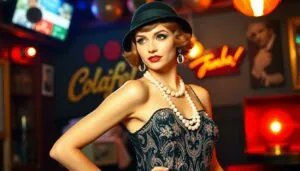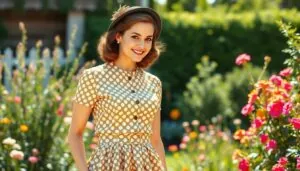Step into the world of the 1890s, where women’s fashion was as dramatic as a Shakespearean play. Picture this: corsets tighter than a drum, skirts so voluminous they could double as tents, and hats that seemed to defy the laws of gravity. If you thought today’s trends were wild, just wait until you see how ladies of the past turned heads and raised eyebrows with their extravagant styles.
In this fascinating decade, fashion wasn’t just about looking good; it was a statement of independence and empowerment. As women began to embrace their newfound freedoms, their wardrobes reflected a bold departure from the past. From the elegant bustle to the daring use of color, 1890s women’s fashion was a delightful mix of tradition and rebellion. Buckle up as we dive into this enchanting era, where every outfit told a story and every woman was a trendsetter in her own right.
Table of Contents
ToggleOverview of 1890s Women’s Fashion
The 1890s marked a turning point in women’s fashion. This decade introduced a blend of flamboyant styles and practical elements, reflecting women’s evolving roles in society. Corsets, tightly laced, created an exaggerated hourglass shape. Voluminous skirts, often adorned with ruffles or flounces, extended outwards, giving a theatrical quality to each outfit.
Silhouettes varied significantly. Bustle skirts became prominent, emphasizing the back and providing a stark contrast to the smaller waistlines created by corsetry. Fabrics like silk, satin, and wool dominated, with intricate patterns and textures enhancing visual appeal. Color palettes shifted toward lilacs, rich burgundies, and vibrant greens, signaling a departure from earlier, more muted tones.
Fashion trends also extended to accessories. Women often topped their outfits with extravagant hats embellished with feathers, flowers, or ribbons. Gloves, usually elbow-length or longer, accentuated the elegance of the overall look. Jewelry featured bold designs, including chokers and statement brooches, reflecting personal style.
The fashion of this era symbolized more than aesthetics. Women embraced their independence and showcased their individuality through clothing. Designers like Charles Frederick Worth influenced trends, pushing boundaries with innovative designs. The 1890s set the stage for future fashion revolutions, demonstrating a striking interplay between traditional values and newfound freedoms.
This decade characterized a unique period in fashion, where each ensemble conveyed empowerment and a desire for self-expression. Societal changes intertwined with fashion, creating a vibrant tapestry of styles that remained influential.
Key Trends and Styles
The 1890s displayed a remarkable diversity in women’s fashion, reflecting their quest for self-expression and identity. This decade introduced striking silhouettes, opulent fabrics, and intricate details that defined the era.
The Hourglass Silhouette
The hourglass silhouette became the signature shape of the 1890s, marked by tightly laced corsets and a fuller skirt. Corsets gained popularity, emphasizing narrow waists and enhancing feminine curves. Bustles added volume at the back, creating an alluring profile that stood in contrast to the more natural lines of earlier decades. Fashion also embraced a mix of structures, featuring both straight-cut bodices and flared skirts. This silhouette served as a symbol of independence and social change, as women began to assert their fashion choices as expressions of individuality.
Fabrics and Patterns
Fabrics played a crucial role in shaping the trends of the 1890s, with a focus on luxurious materials like silk, satin, and lace. Varied patterns adorned garments, from bold stripes to intricate floral designs, creating visual interest. Vibrant color palettes included deep jewel tones alongside softer pastels, allowing for personalized style statements. The use of contrasting textures also became popular, often combining different fabrics within a single outfit. Each detail contributed to a rich tapestry of fashion, reflecting the evolving preferences of women in society.
Influential Designers and Fashion Houses
Charles Frederick Worth emerged as a pivotal figure in 1890s women’s fashion. He founded the House of Worth in Paris, introducing the concept of fashion shows with live models. Worth’s designs emphasized the corseted silhouette and dramatic skirts, making him a trendsetter in the industry.
Maggy Rouff was another notable designer of the decade. She focused on the feminine silhouette, utilizing luxurious fabrics that captured the spirit of the time. Rouff’s innovative draping techniques and rich patterns brought a fresh perspective to women’s clothing.
The influence of the House of Poiret also marked the era. Paul Poiret liberated women from restrictive corsets, promoting a more natural silhouette. His designs showcased bold colors and exotic inspirations, paving the way for modern fashion.
Among American designers, Elizabeth Hawes stood out. She integrated practicality with style, appealing to women seeking both elegance and comfort. Her approach reflected the evolving roles of women in society, blending high fashion with functionality.
Fashion houses like Lanvin and Chanel began to shape women’s attire in the late 1890s. Lanvin’s focus on elegant evening wear catered to the growing middle class. Chanel’s minimalist designs would later revolutionize fashion in the early 20th century.
In addition to these designers, department stores began playing a significant role in fashion distribution. Stores like Macy’s and Harrods showcased ready-to-wear clothing, making fashionable garments accessible to a broader audience. This commercialization of fashion allowed more women to embrace the latest trends, solidifying their place in the evolving fashion landscape of the 1890s.
The Role of Social Movements and Changes
The 1890s witnessed significant shifts in women’s fashion, driven by social movements.
Impact of Women’s Rights Movement
The women’s rights movement greatly influenced fashion during the 1890s. As women fought for suffrage and greater independence, their clothing began to reflect newfound autonomy. Increased participation in public life necessitated practical yet stylish designs, allowing greater mobility. Activists sought to challenge traditional gender roles, which led to the popularization of less restrictive silhouettes. Shift dresses and tailored suits emerged, prioritizing comfort while maintaining elegance. These changes represented not just a shift in style but also an assertion of identity and rights among women.
Cultural Influences on Fashion
Cultural trends also shaped the fashion landscape of the 1890s. The impact of emerging art movements, such as Art Nouveau, introduced organic forms and intricate patterns into clothing designs. Music halls and theater productions popularized flamboyant costumes, influencing everyday fashion. British and French styles mingled in urban centers, creating diverse fashion options. Photography’s rise allowed fashion magazines to disseminate new styles rapidly, inspiring women across various socio-economic backgrounds. This cultural fusion encouraged women to express individuality through diverse attire, setting the stage for modern fashion evolution.
Notable Accessories of the Decade
Accessories in the 1890s added distinct flair to women’s fashion. Extravagant hats topped outfits, showcasing elaborate designs adorned with feathers, flowers, and ribbons. Gloves became an essential accessory, with elbow-length styles complementing evening wear. Jewelry also played a pivotal role, featuring bold pieces like chokers, brooches, and statement earrings that highlighted personal style.
Fascinators emerged as a popular accessory, often perched on the side of the head. These small, decorative hats combined with netting and vibrant accents became symbols of elegance. Reticules, small handbags typically made of silk or velvet, served both fashion and function, allowing women to carry essentials discreetly.
Another notable accessory was the parasol, used to shield from sun rather than rain. Women adorned themselves with parasols featuring intricate lace trim or beautiful patterns, harmonizing functionality and style. Belts also gained prominence, often cinching waists over voluminous skirts to enhance the hourglass silhouette.
Further, hairstyle accessories contributed to overall looks. Hair combs, ribbons, and decorative pins adorned updos, adding extra sophistication. Emphasizing individuality, many women customized these accessories, blending personal flair with contemporary trends.
Historical influences shaped these accessories significantly. As societal norms evolved, women sought to express their burgeoning freedom through fashion choices. The demand for practicality coexisted with a desire for beauty, resulting in accessories that both complemented and transformed outfits. The 1890s thus became a decade where accessories not only completed looks but also reflected women’s growing independence and confidence, distinguishing their fashion moments in history.
The 1890s stand out as a vibrant decade in women’s fashion that beautifully encapsulated the spirit of change and empowerment. With dramatic silhouettes and luxurious fabrics women embraced their individuality through bold choices and innovative designs. This era not only transformed clothing but also reflected the evolving roles of women in society.
As fashion became a canvas for self-expression the impact of influential designers and cultural movements shaped styles that resonated with a growing sense of autonomy. The blend of elegance and practicality marked a significant shift in how women approached their attire paving the way for future fashion revolutions. The legacy of the 1890s continues to inspire modern fashion reflecting the enduring connection between style and identity.



